

| Home | Log In | Register | Our Services | My Account | Contact | Help |
You are NOT currently logged in
dai oldenrich - 01 Sep 2006 13:32
click your browser refresh button to update charts
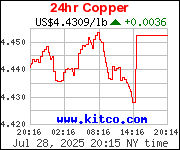
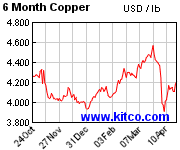
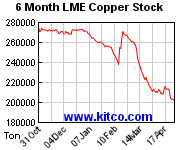
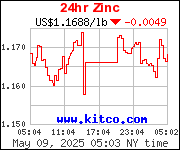
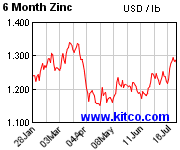
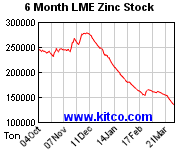
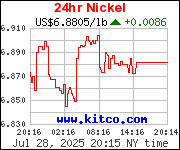
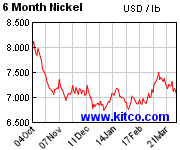
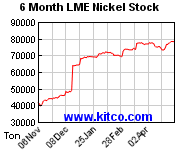
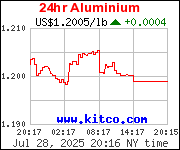
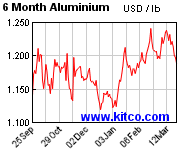
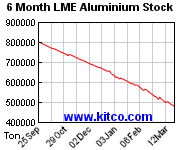
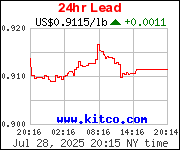
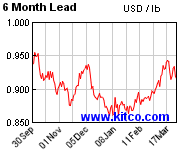
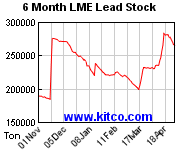
Also see: gold charts here silver charts here platinum charts here
dai oldenrich - 18 Sep 2006 07:00 - 33 of 181
Monday, September 18, 2006 - Dow Jones Newswires
Gold May Recover On IMF Rebuke
Gold's almost 2-week retreat expected to find floor from which to stage some kind of recovery later this week on anticipated scathing IMF statement on various economies frittering away opportunity to rectify imbalances while global growth still strong, says Westpac Australia chief currency strategist Robert Rennie; "that should bode well for USD alternatives and it should see a bit more stability coming back into gold through the week." Adds extent of recovery depends largely on physical demand. But for now views gold as paying price for overly pessimistic view on U.S. economy, dollar. Spot trades last $581.10/oz, up $3.15 on NY close, but down from $640 early this month.(JAD)
dai oldenrich - 18 Sep 2006 07:01 - 34 of 181
Sep 17, 2006 (The Australian Financial Review - ABIX via COMTEX)
Citigroup, JPMorgan and JBWere analysts are among those recommending base metals in September 2006. Although there was a sharp fall in commodity prices and resources stocks in the week ending 15 September 2006, many analysts argue that the fall reflected sentiment more so than fundamentals. There are differences between the recommendations of investment houses, such as Citigroup reducing aluminium forecasts while raising zinc, nickel and copper forecasts. Predictions about supply and demand are also influencing forecasts, especially with zinc.
dai oldenrich - 18 Sep 2006 07:04 - 35 of 181
Sept. 18 (Bloomberg)
Shanghai Copper Futures Increase on Supply Concern in China - By Helen Yuan
Copper in Shanghai rose on concern supplies won't be enough to meet demand in China, the world's biggest consumer of the metal used in power cables and plumbing.
Copper for November delivery on the Shanghai Futures Exchange rose as much as 990 yuan, or 1.4 percent, to 69,630 yuan ($8,766) a metric ton, and traded at 69,440 yuan at 11:30 midday break. The contract fell 7.4 percent last week.
Copper for immediately delivery in Changjiang, Shanghai's biggest copper market, rose as much as 0.6 percent to 70,150 yuan a ton. Chinese users have to pay 17 percent value-added tax, 2 percent import tax, premiums and freight charges for imported copper.
Copper for three-month delivery rose as much as $130, or 1.8 percent to $7,400 a ton on the London Metals Exchange and traded at $7,390 at 11:51 a.m. Shanghai time.
Copper for delivery in December increased 3.85 cent, or 1.2 percent, to $3.3500 a pound on the Comex division of the New York Mercantile Exchange at 11:25 a.m. Shanghai time in after- hours trading.
dai oldenrich - 20 Sep 2006 07:54 - 36 of 181
Wed 20 Sep 2006
Oil marks biggest 1-day decline in 10 years
LONDON (SHARECAST) - Oil prices continued its sharp decline, marking its biggest drop in over ten years on Tuesday amid strong supplies and as concern over problems in the Middle East ease.
US light crude oil for October delivery dropped $2.14 to settle at $61.66 a barrel on the New York Mercantile Exchange.
Oil prices have sunk more than 20% in the last two months, from its high in mid July, as the market cheers rising US inventories.
The latest government data showed crude inventories in the US are around 6% higher than a year ago.
Among precious metals COMEX gold for December delivery fell $9.60 to $583.20 an ounce ahead of this week's US Federal Reserve meeting.
Silver tracked the yellow metals decline, marking a 2.9% slide. Its safe haven qualities failed to come in demand despite the staging of a military coup in Bangkok.
Platinum and palladium also fell on Tuesday.
dai oldenrich - 20 Sep 2006 07:57 - 37 of 181
Copper Falls on Concern U.S. Housing Slowdown May Curb Growth
By Xiao Yu
Sept. 20 (Bloomberg) -- Copper prices fell in London and Shanghai after a U.S. report showed housing construction dropped to a three-year low last month, indicating economic expansion is slowing and demand for the metal may decline.
Housing starts in the U.S. plunged 6 percent last month to an annual rate of 1.665 million, the Commerce Department said yesterday, a steeper slide than economists had estimated. The average home in the U.S., the world's biggest copper user after China, contains about 400 pounds of copper.
``We are concerned the U.S. economy is lacking momentum for growth as the real estate market has been a key supporter of the economy,'' Wang Zheng, a Shanghai-based trader with Dalu Futures Co. said by phone today. ``Slowing economic growth may prompt hedge funds and other investors to short copper.''
Copper for November delivery on the Shanghai exchange fell as much as 2,050 yuan, or 2.9 percent, to 68,920 ($8,692) yuan a metric ton. The contract traded at 69,120 yuan a ton at 11:05 a.m. local time.
Copper for delivery in three months on the London Metal Exchange dropped $135, or 1.8 percent, to $7,360 a ton as of 10:52 a.m. Shanghai time.
Copper has dropped almost 20 percent from a record $8,800 on May 11. The world's economy ``may be turning'' down, International Monetary Fund Managing Director Rodrigo de Rato said yesterday in Singapore. The IMF last week said the strongest economic expansion in three decades will cool next year.
Short Positions
Hedge-fund managers and other large speculators increased their net-short position in New York copper futures in the week ended Sep. 12, the U.S. Commodity Futures Trading Commission data showed on Sept. 16.
Speculative short positions, or bets prices will fall, exceeded long positions by 9,394 contracts on the Comex division of the New York Mercantile Exchange, the Washington-based commission said in its Commitments of Traders report. Net-short positions rose by 671 contracts, or 8 percent, from a week ago.
``There are very divided views on copper prices -- on the one hand, we see signs of a slowing economy; on the other hand, we see supply disruptions of major copper mines worldwide and sound demand in China,'' Dalu's Wang said.
Copper in Shanghai have been risen in the past two days as cable and electric wire producers began to store the metal so they are able to maintain output during a weeklong national holiday next week, traders including Li Ling said yesterday.
dai oldenrich - 20 Sep 2006 07:58 - 38 of 181
FT - By Kevin Morrison - September 18 2006
Investors pull out of commodities
Up to $12bn may have been taken out of commodities by investors over the past month, JPMorgan said on Monday.
The outflows came amid a retreat in commodity prices as concerns increased about a slowing US economy and the knock-on effect of easing demand for raw materials.
ADVERTISEMENT
The investment bank said the gold price could be the most vulnerable to further selling, while crude oil prices were showing signs of support at current levels.
John Normand, global currency, commodity and fixed-income strategist at JPMorgan, said the $12bn of outflows was small relative to the total inflows into commodity index products over the past five years about $100bn.
But he said it was high relative to the amount that had entered through retail mutual funds this year $19bn, according to JPMorgans internal database of about 250 funds.
JPMorgan said about $4.7bn has been sold by speculative investors in crude futures since May, and about $4bn in US gold futures over the same period.
The estimates are based on speculative investment activity measured in the weekly Commitment of Traders report, released by the Commodity Futures Trade Commission, the US regulator. Retail investor activity reflects the assets under management in various commodity-backed ex-change traded funds, it said.
From its peak early last month to its recent trough on Thursday, Brent crude futures tumbled more than 21 per cent, US natural gas has fallen to two-year lows, gold hit a three-month low last week and copper has fallen about 10 per cent in the past month.
The most popular commodity index product, Goldman Sachs Commodity Index, is down this year, in spite of a rise in underlying commodity prices.
An attraction for investors in indices is the ability to earn a roll yield from futures prices being lower than the prevailing spot, or current, price. Investors tend to roll their index trade over each month, just ahead of expiry of the contract.
Traditionally, this trade has been profitable, with investors selling at a higher price and buying at a lower price on the roll. But the roll yield has disappeared in energy futures.
The collapse in commodity prices over the past six weeks has raised the fear of more sustained liquidations, given the sizeable new money flow into this market over the past five years and the negative roll on index products, said Mr Normand.
dai oldenrich - 20 Sep 2006 08:17 - 39 of 181
The Times - September 20, 2006 - By David Robertson
West could lose out to China over aluminium resources
WESTERN mining companies risk handing a substantial prize to China if they fail to commit billions of dollars to developing the aluminium industry of a West African republic.
The Government of Guinea has told Western miners that it will no longer allow them to exploit its vast natural resources unless they also commit to building a domestic refining and smelting industry.
While Western companies, beholden to their shareholders, are reluctant to make the large investment required, Chinas state-owned industries have no such constraints and are looking to get fully involved.
Guinea has 26 per cent of the worlds known reserves of bauxite, the raw material used to make aluminium. Nearly all its ore, which is of very high quality, is exported for processing. Some of the worlds biggest miners have bauxite concessions in Guinea, including BHP Billiton, Alcoa and Alcan.
Ousmane Sylla, the Mines Minister, told The Times yesterday that companies would be encouraged to set up refineries in Guinea to convert the raw bauxite into alumina. He also wants them to build smelters, in which the alumina can be turned into aluminium. Each process significantly increases the value of the raw material.
Dr Sylla, in Moscow for the aluminium industrys annual conference, said: Guinea is a very rich country in terms of resources but a very poor country economically. I believe that can change only if we develop our industry. Through this, Guinea will fight poverty.
The biggest hurdle is power. Refineries and smelters are energy-intensive processes and tend to be located where cheap power is available. Guinea wants miners to invest in hydroelectric power schemes, but senior industry executives have told The Times that they are unwilling to commit themselves to a multibillion-dollar investment in what they see as a politically unstable country.
China appears willing to cooperate. Dr Sylla was in Beijing last month to talk to Chalco and the China Aluminium Group, and Chinese engineers are expected in Guinea soon. Sino Hydro, the Chinese power company, is sending a delegation.
One industry source said: The Chinese need access to more high-quality bauxite, and Guinea is the obvious place for them to go. Chinese state-owned companies . . . are the only ones that will buy into Guineas new policy, which means China may end up controlling 26 per cent of the worlds bauxite supply.
happy - 21 Sep 2006 07:19 - 40 of 181
dai oldenrich - 21 Sep 2006 07:21 - 41 of 181
MarketWatch - 20 September 2006
Gold falls in electronic trade after Fed decision
Gold futures prices closed higher for Wednesday's regular trading session, then fell in electronic trading, while metals-mining shares cut their gains or retreated shortly after the Federal Reserve decided to leave interest rates unchanged
The Fed held overnight interest rates steady at 5.25% and left the door open for further increases if inflation does not come down. This was the second straight meeting with no change in monetary policy. It follows rate hikes at an unprecedented 17 consecutive policy-setting meetings.
The news came less than an hour after the regular metals trading session ended on the New York Mercantile Exchange.
Gold for December delivery ended the regular session with a gain of $3 to close at $586.20 an ounce. It briefly touched a high of $592.50 during the day, after spending two sessions gaining and then losing nearly $10 an ounce.
In electronic trading, prices traded between a low of $585.10 and a high of $587.40, with the contract down 50 cents at $585.70, about 15 minutes after the Fed announcement.
"The Fed states there is moderation in economic growth reflecting a cooling housing market, crude-oil price declines should temper inflation but added inflation risks remain," said John Person, president of National Futures Advisory Service.
"Gold should stabilize and trade lower for the remainder of the week to re-test the July lows near the $558 level," he said.
The dollar continued to trade slightly weaker against its major foreign rivals following the news, but failed to offer support for gold.
Concerns about weak jewelry demand in the first half of the year and a sharp selloff in the oil pits pushed gold prices lower Tuesday. Oil prices fell again Wednesday to below $61 a barrel after U.S. government data showed that crude supplies remained ample despite a third-weekly decline.
Peter Grandich, editor of The Grandich Letter, believes gold is rapidly approaching a bottom, blaming much of its recent weakness on central bank selling.
"Strong physical demand and a whole host of positive technical divergences strongly suggest the next $100 move is up, not down," he said in comments emailed Wednesday morning.
However, the outlook for copper is less upbeat, with London Metals Exchange inventories up again for a 32% gain since June.
"Copper is on the verge of a major breakdown." he said. "A $2 copper price in 2007 is a realistic target."
December copper closed nearly unchanged in Wednesday's regular session, up 0.05 cent at $3.376 a pound.
December silver futures climbed 19.5 cents to end at $11.14 an ounce, October platinum fell $14.90 to close at $1,140 and December palladium fell $2.70 to finish the day at $306.35 an ounce.
On the supply side, gold inventories were down 64 troy ounces at 7.79 million troy ounces as of late Tuesday, according to Nymex data. Silver supplies fell by 126,199 troy ounces to 105.6 million and copper supplies rose by 2,260 short tons to 17,523 short tons.
dai oldenrich - 21 Sep 2006 07:33 - 42 of 181
Copper Rises in Shanghai as Producers Buy After Price Decline
By Chia-Peck Wong
Sept. 21 (Bloomberg) -- Copper in Shanghai rose as cable and electric wire makers in China, the world's biggest user of the metal, resumed purchases after yesterday's price declines.
Copper prices fell 2.6 percent yesterday, the biggest drop since Sept. 12, to settle at 69,100 yuan a metric ton, a level which may prompt buying by producers keen to store the metal to maintain output during a weeklong national holiday next month.
``Below 70,000 yuan, we see some buying from copper users,'' Li Rong, a metal analyst at Great Wall Futures Corp., said by phone today from Shanghai.
Copper for delivery in November rose as much as 1,090 yuan, or 1.6 percent, to 70,190 yuan ($8,857) a metric ton on the Shanghai Futures Exchange. It traded at 69,470 yuan by the market's midday break.
In the past week, the metal has twice settled above 70,000 yuan and then settled below that figure for the following two days, indicating resistance, or levels where selling orders cluster, on charts some traders use to predict prices.
The exchange will be closed from Oct. 2 to Oct. 6 for the annual National Holiday, and is due to reopen on Oct 9.
Copper for immediately delivery in Changjiang, Shanghai's biggest copper market, rose as much as 0.9 percent to 70,860 yuan a ton. Chinese users have to pay 17 percent value-added tax, 2 percent import tax, premiums and freight charges for imported copper.
Copper for three-month delivery fell $49, or 0.7 percent, to $7,400 a ton on the London Metal Exchange at 11:44 a.m. Singapore time.
Metal for delivery in December fell 2.1 cents, or 0.6 percent, to $3.355 a pound on the Comex division of the New York Mercantile Exchange at 11:45 a.m. Singapore time in after-hours trade.
dai oldenrich - 23 Sep 2006 08:00 - 43 of 181
By Chanyaporn Chanjaroen and Dale Crofts
Sept. 22 (Bloomberg) -- Copper prices rose in New York, capping a 3.9 percent gain this week, on speculation that supplies will lag behind demand because of mine disruptions and dwindling stockpiles.
Inventories monitored by the London Metal Exchange fell 1.7 percent today to 121,275 metric tons. That's equivalent to less than three days of global use. Stockpiles have dropped 3.3 percent this month. Copper prices have doubled in the past year.
``All types of copper stocks will be at critically low levels, and the market from mine to consumer will remain tight,'' Simon Toyne, a London-based metals analyst at Numis Securities, said today in a report.
Copper futures for December delivery gained 0.85 cent, or 0.3 percent, to $3.44 a pound on the Comex Division of the New York Mercantile Exchange. Prices tumbled 7.2 percent last week after climbing for three straight weeks.
A futures contract is an obligation to buy or sell a commodity at a fixed price for a specific delivery date.
On the LME, copper for delivery in three months fell $15, or 0.2 percent, to $$7,545 a metric ton. Prices still gained 3.8 percent this week. The metal reached a record $8,800 a ton on May 11.
Six of 13 analysts, investors and traders surveyed by Bloomberg yesterday forecast copper will rise next week. Four expected a drop and three predicted little change.
Demand will exceed supply by 52,000 tons in 2006, compared with a shortfall of 360,000 tons last year, Goldman Sachs Group Inc. analysts led by London-based James Gutman said in a Sept. 18 report. The bank raised its average price forecast in 2006 by 18 percent to $6,617 a ton.
Chile, Indonesia
A strike last month at BHP Billiton Ltd.'s Escondida site in Chile reduced production. Grupo Mexico SA also lost output this year due to a labor dispute. Freeport-McMoRan Copper & Gold Inc. has reported declining output at Grasberg in Indonesia because of ore containing less metal. Escondida is the world's biggest copper mine, followed by Grasberg.
Canadian nickel miner Inco Ltd. has suspended delivery of copper concentrates from its Voisey's Bay mine in Labrador, Canada, to three customers in Europe, Inco spokesman Steve Mitchell said by phone from Toronto today. Workers at the mine have been on strike there for about eight weeks.
Copper in London has traded in a range of $7,035 to $8,080 a ton since July.
``There's a lack of consensus'' on whether there will be oversupply or a shortfall next year, said Andrew Silver, a London- based trader at Natexis Commodity Markets Ltd.
When prices of copper fall by $200 to $300 a ton, consumers buy the metal, minimizing losses, Silver said. Producers start selling when prices rise, capping gains.
Housing Data
Prices may decline next week should data in the U.S. indicate economic growth is slowing, eroding demand for copper by the world's second-largest user of the metal.
The National Association of Realtors, the U.S. industry's largest trade group, may say sales of existing homes fell in August to the lowest rate in almost three years, according to a Bloomberg survey of economists. Housing accounts for 37 percent of U.S. copper demand, according to Citigroup Inc.
``As the market looks ahead to next week, it's anticipating more bad news,'' said Ronald Goodis, retail trading director at Equidex Brokerage Group Inc. in Closter, New Jersey. ``Stocks are coming down, and bonds are moving higher, indicating that all markets are focusing on the health of the economy.''
The realtor group predicts U.S. home prices may dip below year-earlier levels in coming months and said on Sept. 8 that record home supplies may erode prices for the first time in 13 years.
dai oldenrich - 24 Sep 2006 06:33 - 44 of 181
FT - September 23 2006 - By Christopher Brown-Humes
Times are tough for the bulls on oil and commodity stocks. The sharp falls in oil prices since July have coincided with fresh bouts of trouble for sector heavyweights BP and Shell. That has raised doubts about one of the biggest and most successful trades of the past few years - overweight oils and miners. But the bulls should hold on. The story is not yet over, even if the ride is going to get bumpier.
It is a call which has ramifications for the wider UK market. London has been underperforming, precisely because resources stocks have been falling and because there is a greater weighting of these in London than in other European markets. While the FTSE All Share is nearly 5 per cent below its April 21 peak, the FTSE Eurofirst 300 index was at four-month highs on Thursday. Its close yesterday was only 2.5 per cent below the five-and-a-half-year peak in May.
Resources stocks have succumbed to profit-taking after the big gains of recent years. The FTSE All Share Oil and Gas index is down 11.5 per cent since April 21, while the Mining index is down 11 per cent. The heaviest falls have taken place in the past month. Given that mining accounts for six per cent of the All Share - it was less than two per cent in 2000 - and that oil and gas is 15 per cent, it is not hard to see why London shares have been struggling to make progress. This is despite the fact that many sectors of the economy are potential beneficiaries of lower oil prices.
US oil prices have fallen 20 per cent to $61 a barrel since early August, gold is down by the same amount since its 26-year peak in May, and copper has fallen 13 per cent since May. One of the reasons for the falls is that slowing US demand has become a greater worry for markets than rising inflation now that there is evidence of a drop in US housing activity and that the Federal Reserve has stopped raising interest rates. If fewer new homes are built in the US, there won't be as much need for copper piping, for example. At the same time, a US slowdown could have an impact on the wider global economy, particularly the Chinese one, because of the importance of US exports to China.
But lower oil prices are not the only reason oil and gas shares have been falling. BP has become mired in all sorts of difficulties in the US following a blast at one of its Texas refineries, pipeline corrosion problems in Alaska and production delays at its Thunder Horse oil field in the Gulf of Mexico. These issues are clearly taking their toll on BP's share price, which has underperformed Exxon Mobil's by 10 per cent this year. Royal Dutch Shell also faces company-specific issues, including interference by the Russian authorities in the Shell-led Sakhalin-2 project.
The question is whether oil and gas stocks are now undervalued, with ABN Amro noting this week that the oil and gas sector was trading at a record discount to the market. The oil and gas index price/earnings ratio is 9.11 compared with 12.87 for the FTSE All-Share. That's probably fair if you think oil is heading back towards $40 a barrel and believe oil and gas earnings have been heavily inflated by oil price strength.
But there are many reasons for believing that the oil price drop is temporary. The US driving season is over, so demand for gasoline is lower. But soon demand for heating oil will start to increase as winter approaches. Hurricanes have been notable by their absence, while concerns about Iran have temporarily dissipated. It is all too easy to imagine new geopolitical tensions. As for BP's US problems, it is far too early to say that it is out of the woods, but its share price is already probably discounting many of the problems it is experiencing there.
Mining stocks are also trading on a low price/earnings ratio of about 8.5. That suggests the market believes earnings are heading for a sharp fall as commodities prices drop. There are concerns about corporate governance at some big international mining groups that have joined the London stock exchange in the past few years.
Yet commodities demand remains robust in China and India, corporate balance sheets are strong even if commodity prices fall further, and there is every prospect of increased dividends and further share buy-backs. Moreover, there are good reasons for expecting consolidation in the mining sector to continue, because it can be cheaper to buy companies than spend money on exploration and development. Anglo-American - in which Chinese investors were this week rumoured to be building a stake - is only the latest mining company to feature in the regular consolidation gossip surrounding the sector. On balance, resources shares are attractive, providing you believe that global demand will slow rather than collapse next year.
dai oldenrich - 24 Sep 2006 06:33 - 45 of 181
FT - By Kevin Morrison
Investors pull out of commodities
Up to $12bn may have been taken out of commodities by investors over the past month, say JPMorgan.
The outflows came amid a retreat in commodity prices as concerns increased about a slowing US economy and the knock-on effect of easing demand for raw materials.
The investment bank said the gold price could be the most vulnerable to further selling, while crude oil prices were showing signs of support at current levels.
John Normand, global currency, commodity and fixed-income strategist at JPMorgan, said the $12bn of outflows was small relative to the total inflows into commodity index products over the past five years about $100bn.
But he said it was high relative to the amount that had entered through retail mutual funds this year $19bn, according to JPMorgans internal database of about 250 funds.
JPMorgan said about $4.7bn has been sold by speculative investors in crude futures since May, and about $4bn in US gold futures over the same period.
The estimates are based on speculative investment activity measured in the weekly Commitment of Traders report, released by the Commodity Futures Trade Commission, the US regulator. Retail investor activity reflects the assets under management in various commodity-backed ex-change traded funds, it said.
From its peak early last month to its recent trough on Thursday, Brent crude futures tumbled more than 21 per cent, US natural gas has fallen to two-year lows, gold hit a three-month low last week and copper has fallen about 10 per cent in the past month.
The most popular commodity index product, Goldman Sachs Commodity Index, is down this year, in spite of a rise in underlying commodity prices.
An attraction for investors in indices is the ability to earn a roll yield from futures prices being lower than the prevailing spot, or current, price. Investors tend to roll their index trade over each month, just ahead of expiry of the contract.
Traditionally, this trade has been profitable, with investors selling at a higher price and buying at a lower price on the roll. But the roll yield has disappeared in energy futures.
The collapse in commodity prices over the past six weeks has raised the fear of more sustained liquidations, given the sizeable new money flow into this market over the past five years and the negative roll on index products, said Mr Normand.
dai oldenrich - 24 Sep 2006 06:33 - 46 of 181
ABC News - By Stephen Long
IMF issues warning on commodities boom
High commodity prices are driving Australia's economic growth, but the International Monetary Fund (IMF) says those prices are set to fall.
The IMF warns that some of the buoyant demand from China may be temporary.
It is tipping that over the next four years, prices for aluminium will fall by more than a third and for copper by more than 50 per cent.
The IMF's head of research, Tim Callen, says the IMF is expecting global growth of 5.1 per cent this year, and then slowing slightly to 4.9 per cent next year.
"I mean, the basis for this forecast is we're still seeing data, generally at the global level, coming in pretty strongly, and we expect that largely that'll continue going forward," he said.
"But we do see some risk to the outlook, particularly the US housing market is a concern, that the activity there is clearly slowing, and there are questions about the strength of that impact on US activity going forward.
"If the US slows more than expected, clearly that would have an impact on global growth."
He says the US housing market downturn will impact on growth.
"We could certainly imagine a scenario, if house prices slow more sharply than we have in our central forecast, of US growth maybe being one percentage point lower than we have in our forecast next year," he said.
"We're currently expecting 2.9 per cent growth next year."
Mr Callen says the IMF estimates that slowing would probably reduce growth in the rest of the world by about a quarter to half a percentage point.
"We certainly do see the downside risks I think as being slightly more skewed than we would normally, because basically we've had four years of very strong global growth," he said.
"The output gap at the global level is now, you know, closing in to where the global economy's operating near full capacity.
"In that situation it's certainly true the number of risks that are out there. If we get a combination of those risks in particular, we could see a considerable downside impact in our view."
Commodities drop
Mr Callen says it is very hard to predict commodity prices in the short-term, but the research points to "quite a substantial decline in aluminium and copper prices" over the next five years.
The IMF has predicted a 50 per cent fall in copper prices over the next four years.
Australia is more reliant on iron ore and coal, but this must raise worries about Australia's growth, given this country's reliance on commodity exports.
"I think the two things to consider here, right, first of all clearly there's a lot of investment going on into the commodity sector," he said.
"So there's going to be an increase in the volume of exports of these metals as well. At the same time, prices are declining.
"While demand for commodity prices will continue to increase strongly over the next few years, in good part because of China's strong growth, it's actually the investment that's going into the supply side that will bring a lot of capacity on to meet that demand, at declining prices, over the next five years."
US wage pressure
He says that on a three-month annualised basis, core CPI in the US is running in the 3 to 3.5 per cent range.
"But the expectation is that as growth in the US continues to slow a little bit, and as oil prices have declined, that this should begin to take some of the pressure off inflation," he said.
"But clearly in the US, there's a delicate balance that the Fed is trying to get at the moment.
"What we expect is that as growth slows we will see some easing of inflationary pressures going forward.
"Of course, the risk on this side is more that if productivity growth slows more than expected, we could see slowing growth against a background of continued upward pressure on inflation."
He says the Chinese economy is growing very strongly, "but China would not be unaffected by a slowdown in US consumption growth.
"So we would see, if the US economy does slow, this is certainly going to have implications for the global economy as a whole."
dai oldenrich - 25 Sep 2006 07:22 - 47 of 181
Dow Jones Newswires - Monday, September 25, 2006
Copper Looks Trapped In $7,600-7,200 Range
LME 3-month copper $7,560/ton, up just $10 on Friday's London PM, expected to continue encountering firm resistance at 100-day moving average at $7,600, says Standard Bank. On downside, $7,200 remains important support with sustained move below possibly triggering extended downward spiral. Fundamental newsflow mixed, as LME warehouse stocks continue to shrink, gold firmer Friday night while energy markets softer, threatened strike at Spence project in Chile apparently averted.
Copper Looks Trapped In $7,600-7,200 Range
LME 3-month copper $7,560/ton, up just $10 on Friday's London PM, expected to continue encountering firm resistance at 100-day moving average at $7,600, says Standard Bank. On downside, $7,200 remains important support with sustained move below possibly triggering extended downward spiral. Fundamental newsflow mixed, as LME warehouse stocks continue to shrink, gold firmer Friday night while energy markets softer, threatened strike at Spence project in Chile apparently averted.
fez - 25 Sep 2006 08:10 - 48 of 181
fez - 25 Sep 2006 21:45 - 49 of 181
Daily Telegraph - 25/09/2006 - By Peter Foster in New Delhi and Harry Wallop
Indian court blasts 400m Vedanta refinery
Vedanta Resources, the mining giant, has been accused of a ''blatant violation" of planning and environmental guidelines during the construction of a 400m aluminium refinery in the Indian state of Orissa.
An Indian Supreme Court committee set up to review the Lanjigarh alumina refinery project found environmental clearances were granted on the "wrong premise" that the refinery and a proposed open-cast mine would not encroach on protected forests.
The 60-page report criticises Vedanta, which floated in London three years ago, and recommends that the court should "consider revoking" clearances given to the company by New Delhi in September 2004.
The massive Lanjigarh project, which was begun in 2003, has attracted fierce protests from tribes who claim the refinery and a proposed mine will be an environmental disaster.
The scheme is the most important expansion project Vedanta is investing in across India. Any moves to derail the plans would be a blow to the ambitious company, which entered the FTSE 100 earlier this year.
The two-phase project was conceived as a refinery that would be fed by a bauxite mine spread over 660 hectares of the nearby Niyamgiri Hills, linked to the refinery by a conveyor whose pylons are partly constructed.
Ecologists say the hills contain rare species of plant as well as populations of elephant, wolf, giant squirrel and pangolin as well as endangered species such as leopard, tiger and a rare antelope.
Though construction on the refinery is complete, permission for the mine, which was to supply 3m tonnes of ore a year to the refinery, is awaiting the outcome of fresh environmental impact studies ordered by the Supreme Court.
However, the report by a Centrally Empowered Committee of the court said Vedanta should never have been given permission to build the refinery because it failed to apply for the mine at the same time.
Under planning guidelines work on constructing the refinery, should not have started because the mine was situated on land protected under India's Forests (Conservation) Act of 1980.
"The [Lanjigarh] Alumina Refinery construction work has been started and continued in blatant violation of the above said guidelines," the committee said.
The committee added further that Vedanta should not have built the refinery before conducting an "in-depth study" into the impact of the mine on flora, fauna and water regime of the Niyamgiri Hills.
A two-day visit by the court in December 2004 found tribes had been denied adequate grazing and agricultural land.
Vedanta is trying to find alternative sources of ore for the Lanjigarh plant which raises questions about the economic success of the refinery without the planned mine to supply it. Sources within the company insist getting ore from elsewhere would only have a "minimal" effect on the profitability of the project. The report, submitted in September last year, shows Vedanta being forced into a U-turn over whether the Lanjigarh refinery plant was or was not - dependent on the mine for its commercial viability.
In an affidavit of February 2 2005, Vedanta stated the Lanjigarh refinery considered the proximity of bauxite deposits. "A situation of the Lanjigarh deposits not being available to the refinery has never been envisagedand therefore the suggestion to source bauxite from alternative sources is not apprehendable [sic]...", it said.
However the company rapidly changed its position when told by the committee that, if the mine was integral to the refinery, they should have sought permission for both projects at the same time.
In a second affidavit issued a month later, Vedanta sought to ''clarify" the position, saying the mine was not ''integral" to the refinery and that the company would obtain ore from other sources if necessary.
The committee replied that, if the mine were not "absolutely necessary" for the refinery, then, under the conservation law, it would "probably not be approved" by the Indian government.
Having apparently fatally undermined its own case, Vedanta changed its mind yet again, submitting a third affidavit in April 2005 reverting to its original position that mine was necessary if the refinery was to be successful.
Vedanta said: "The proximity of mine would be an important factor for the successful functioning of the refinery and the production of aluminium at competitive prices."
Vedanta must now await the outcome of two environmental studies on hydrology and wildlife impact before a decision is made as to whether the Niyamgiri Hills can be mined or not.
However, leaked reports of a Wildlife Institute of India study conducted in May did not appear favourable to the mine, citing "irreversible" impact on the ecology. Activists, who plan to demonstrate next week, fear political pressure will be applied to secure the mining rights to the site.
Last month, Anil Agarwal, the chairman of Vedanta who started as a scrap metal dealer in Mumbai, announced he would spend 550m of his personal wealth to open a new university in Orissa state.
Srikanta Jena, a senior Congress Party leader who opposes the project, told The Daily Telegraph that he believed Vedanta should cut its losses and wind up the plant. "Without the mine, this plant is a white elephant," he added, "it is an illegal project which will damage the environment and bring little or no development to this area."
The company refused to comment on the details of the Supreme Court investigation, but said: "Vedanta's investment is set to transform Orissa, providing thousands of jobs. Vedanta supports a number of projects in the region on health, education and the environment, directly benefiting a huge number of people."
fez - 25 Sep 2006 22:03 - 50 of 181
dai oldenrich - 25 Sep 2006 22:08 - 51 of 181
Sept. 25 (Bloomberg) - By Chanyaporn Chanjaroen
Copper Falls as U.S. Housing Data Signals Metal Demand May Slow
Copper fell in London as lower home sales and prices in the U.S. signaled demand for the metal used in wires and pipes may slow.
Copper has plunged 16 percent from a record in mid-May on signs the economy is slowing. The median price of previously owned homes in the U.S., the world's second-biggest copper consumer behind China, fell 1.7 percent in August, the first decline in 11 years and the lowest since early 2004, the National Association of Realtors said. Purchases dropped 0.5 percent to an annual rate of 6.3 million.
``The market is becoming more concerned about slower economic growth in the U.S., which means slower demand for metals,'' said Michael Widmer, head of metals research at Calyon in London. Calyon is among 11 companies that trade on the floor of the London Metal Exchange.
Copper for delivery in three months fell $35, or 0.5 percent, to $7,510 a metric ton on the London Metal Exchange, the world's largest metals market. Prices have quadrupled in the past five years, reaching a record $8,800 on May 11, as demand growth outpaced mine output, eroding inventories.
The median price of a previously owned U.S. home declined to $225,000 last month from $228,000 in August 2005, the first decrease since April 1995, the realtors group said. Home sales haven't increased since February. As much as 400 pounds of copper is used in the average U.S. house.
The data ``confirms the relatively sudden landing in the U.S. housing market, and suggests that both selling prices and construction are set to fall further in the next six months,'' John Kemp, a London-based metals analyst at Sempra Metals, said in a report.
Copper Stockpiles
Dwindling demand for the metal may increase inventories, Calyon's Widmer said. Stockpiles monitored by the LME increased 350 tons, or 0.3 percent, to 121,625 tons today. That's still less than three days of global consumption.
BHP Billiton Ltd., the world's largest miner, avoided a strike at its Spence copper mine in Chile. Workers voted to accept a three-year contract that includes a wage increase and a bonus, Andres Ramirez, union president, said yesterday. Workers had planned a strike tomorrow. Spence is scheduled to start production in the fourth quarter.
Hedge-fund managers and other large speculators increased their net-short position, or bets prices will fall, by 18 percent to 11,042 Comex copper contracts in the week ended Sept. 19, according to the Commodity Futures Trading Commission. Net- short positions rose by 1,648 contracts, or 18 percent, from a week earlier.
Pared Losses
Copper in New York pared losses in late trading as oil prices rebounded.
``The losses started to come off when the energy market turned around,'' said Tom Hartmann, a commodity broker at Altavest Worldwide Trading Inc. in Mission Viejo, California. ``Some of the bears may have capitulated in the short term with the rally in oil.''
Copper for December delivery rose 0.4 cents, or 0.1 percent, to $3.4475 a pound on the Comex division of the New York Mercantile Exchange, after dropping as much as 9.85 cents, or 2.9 percent, to $3.345. Before today, prices had gained 69 percent this year. A futures contract is an obligation to buy or sell a commodity at a fixed price for a specific delivery date.
Demand will exceed supply by 52,000 tons in 2006, compared with a shortfall of 360,000 tons last year, Goldman Sachs Group Inc. analysts led by London-based James Gutman said in a Sept. 18 report. The bank raised its average price forecast in 2006 by 18 percent to $6,617 a ton.
dai oldenrich - 26 Sep 2006 07:04 - 52 of 181
Platts Metals Alert - 09/25/06
Copper was stuck in a tight range during Monday's premarket session on the London Metal Exchange, while market players were continuing to closely watch out for further action on fund favorites--aluminium and zinc. Three-months copper was bid down $120 at $7,430/mt at 0901 GMT from Friday's kerb close of $7,550/mt. The red metal would need to hold first line support at $7,250/mt or risk falling further, warned an LME trader. On the upside, copper would need to close above $7,600/mt to cement a new drive higher, he added. Copper's current range of $400 was deemed to be rather small, he said. "It [copper] seems to be fairly indifferent to the usual influences like gold, oil etc....and the short term guys don't have a position at the moment," he suggested, adding that even the funds weren't currently active in the red metal either. "The long term guys didn't get strong enough signals on copper [to be able to make any new positions]," he added.
In contrast, aluminium and zinc have been very well traded of late with large volumes seen done on the exchange, he said. Aluminium has a good "base of business" and very active fund buying, he added. The metal was trading an extremely wide range sandwiched between support at $2,400/mt and overhead resistance at $2,680/mt. Although in the short term the range was seen at $2,480/mt to $2,550/mt, suggested the trader. With fundamentals for aluminium in equilibrium, the metal seemed to be drifting. "It needs an outside influence to move it...some money flying around for example...at the moment it's anyone's guess which way it will go," he added. Total aluminium stocks were up a net 2,300 mt at 695,350 mt, according to LME data Monday. Zinc prices were markedly lower at $3,310/mt, off over $100 from its previous kerb close. The metal would need to hold on to support at $3,320/mt, he said.
"Zinc is more prone to bigger downside corrections...the way it is traded--it is more prone to setbacks," the trader explained. Meanwhile, in the rest of the base metals complex nickel was bid $250 lower at $27,350/mt, down from Friday's close of $27,600/mt. Stock-watching remained the theme of the nickel market, he said, adding: "If the nickel stocks stabilize or creep up then the price will come off." The trader suggested that if the short stock situation eased sufficiently and nickel didn't have the fundamentals to prop it up, then three-months nickel prices could easily see as much as $5,000/mt sliced off. "Many in the market have been using the LME stocks as a visible indicator on nickel," he added. LME-registered nickel stocks were barely moved Monday, showing a 6 mt rise to a total 6,036 mt with just 3,288 mt available on warrant. Tin was off $25 at $8,900/mt, while lead was off $12 at $1,350/mt. Aluminium alloy was bid at $2,220/mt with the NASAAC at $2,190/mt.